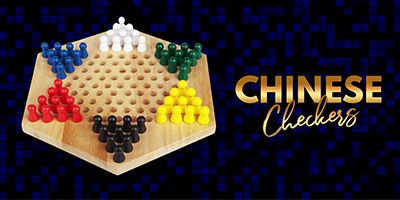Chinese Checkers
Chinese checkers, sometimes known as Chinese chequers, is a German strategy board game that can be played by two, three, four, or six persons, individually or with partners.
Each player competes to be the first to move or jump a set of marbles from a home point to the opposing point of a pitted 6-pointed star.
Chinese Checkers History
The oldest form of checkers, according to historians, was played approximately 3,000 B.C.E. Archaeologists discovered it in Iraq's ancient city of Ur.
Alquerque was an ancient checkers variant that was played in ancient Egypt as early as 1,400 B.C.E. For thousands of years, Alquerque was extremely popular throughout the Western world.
Checkers, as we know it now, is thought to have originated around the beginning of the 12th century. The notion of playing checkers on a chess board comes from a Frenchman. The game was known as "Fierges" or "Ferses" at the time. The game made its way to England and the Americas with a new board design and set of rules.
According to some reports, the name "Chinese Checkers" was coined in the United States in 1928 as a marketing ploy by Bill and Jack Pressman. The game was originally known as "Hop Ching Checkers" by the Pressman firm. According to some reports, the game's present name comes from the Chinese flag's star.
How to Play Chinese Checkers?
With 2 to 6 players, Chinese Checkers is a delightful game to play. The game can be played in a variety of ways. Despite the fact that different regions have their own variations on the game, here's how to play Chinese checkers the way the rest of the world does.
Objective of Chinese Checkers:
The goal of Chinese checkers is to get all of your marbles to the star's opposite position. The player who completes this task first wins.
Equipments to Play Chinese Checkers:
The Chinese Checkers board, also known as Chinese Chequers, is shaped like a six-pointed star. Each point of the star is made up of ten holes in a triangle (four holes to each side). The board's interior is a hexagon, with five holes on each side. There are six sets of ten pegs with corresponding colours for each triangle.
Learn How to Play Chinese Checkers in Steps:
- Learn How to Use the Board: The board is shaped like a six-pointed star, with 10 "peg" (or marble) holes in each point. The board's inner hexagon is also covered in peg holes, and each side of the hexagon contains five peg holes.
- Pick a Starting Triangle: The amount of triangles you utilise will be determined by the number of players. The game can be played by two, three, four, or six players. The following are the rules to follow when playing this game with the appropriate amount of players:
- Arrange Your Pegs: Use the ten pegs that match to your triangle's colour. However, color-coded triangles are not seen on all Chinese Checkers boards. In this situation, you have the option of selecting any coloured set of pegs.
- Take Turns Playing: Following the first person's turn, the player on that player's left should take their turn. Continue in this manner around the board, going to the left until you reach the first player once more. The cycle then starts all over again.
- Attack Your Opponents: Pegs on the board can be moved in any direction. You can even shift them into triangles that aren't in use right now. You must move all 10 of your pegs into the triangle directly across from your beginning triangle to win the game.
- Move to One Adjacent Hole At a Time: The most simple method of moving a peg is to place it in a nearby hole. Pegs can travel in any direction: forward, backward, or side to side. Unless you choose to "jump" your peg over another peg, you can only slide one peg into one vacant hole per turn.
- Jump Over the Pegs: Another option is to "hop" over adjacent pegs and into a vacant hole on the opposite side. Only one peg must be blocking your path to the empty hole, and the empty hole must be precisely beyond that peg and in the same direction as the peg you're moving.
- Do Not Remove Pegs: Pegs from a Chinese Checkers board should never be removed. Those pegs do not move unless the player who is using them decides to do so.
- Keep Your Peg in the Destination Triangle: Once you've moved one of your pegs into the opposing triangle, you can't move it out for the rest of the game. You can, however, move it within that triangle.
Chinese Checkers Rules
The best parts about any game is finding a way to go around the rules so you can win the game. So here are the Chinese checkers rules! What you want to do with them is totally up to your imagination.
What are the Rules for Chinese Checkers?
- If a player is unable to move any pegs during a turn, they must forfeit the game.
- A player's turn allows them to move one marble. The marble can be transferred to a nearby open spot or jump over other marbles in its immediate vicinity.
- You can only leap over one marble at a time, but you can line up many jumps on the same turn.
- Any marble can be hopped over in any direction, as well as any peg, including your own.
- During a single turn, you can jump over as many pegs as you want as long as you only move one peg. Each peg you hop over must be in accordance with the position of your current peg.
- This is the only way to move a peg more than once during a turn, and utilising this strategy, you could conceivably hop your way across the entire board in one turn.
- Pegs that have been moved to non-destination triangles can still be removed.
Chinese Checkers Strategy to Win Every Time
Whenever you play checkers game, your opponents are always expecting you to come up with complex strategies. So tricking them into believing that you have an ace up your sleeve is the best way to go. But to really throw them off, you will need to learn Basic chinese checkers board game strategy.
- The Set Up: Moving the checker on the right or left of the triangle toward your opponent's checkers is the greatest approach to get a few checkers out of your region. Then you hop over the third and fifth checkers with one of the second checkers from the triangle's corner.
- Try and Keep Your Pieces in the Centre of the Board: It's less probable for your pieces to become stranded if you keep them away from the side. Setting up a zigzag line with your pieces is an excellent strategy to get pieces to the middle of the board. Then you can jump over the other pieces with the last piece in the line. You can advance in Chinese checkers by hopping over the pieces in front of your checker. You can hop all the way along the line of your pieces if you have one piece in the back and a zigzag of other pieces across the board.
- Avoid Stragglers: Rather than having a lead scout marble or a marble stuck in the back, move your marbles as a group. If you have a marble in front of you or stuck in the back, you won't be able to go forward with your other marbles. Similarly, if you have a marble in front of you, the marbles behind it are useless. Marbles can travel ahead by hopping on one another, but they must be close enough to do so.
- Take the Direct Route: The goal is to use all of your pieces to fill the tip of your opponent's star before they do the same to you. Because speed is crucial, you want to move your pieces as quickly as possible through the middle of the board. Obviously, how your opponent moves will influence this, but you don't want to be pushing your pieces into unoccupied areas of the board.
- Go Defensive: A stay-at-home tactic is used by some players. This entails keeping one checker at the very tip of your star, preventing your opponent from entirely filling it. Keep in mind that you won't be able to win this manner because you'll have to shift it out at some point in order to fill up your opponent's star.
- Anticipate Your Opponent: Make an effort to pay attention not only to your own strategies but also to what your opponent is attempting to achieve. One of the most important aspects of Chinese checkers is blocking your opponent. Consider yourself in your opponent's shoes and consider your next best action.
Chinese Checkers vs Poker
Poker |
Chinese Checkers |
|
Poker is a card game that is played all over the world. |
Chinese Checkers is a board game played with marbles/pegs. |
|
The objective of playing poker is to win the pot. |
The objective is to get all your marbles into the destination triangle before your opponent. |
Chinese Checkers FAQ’s
1.) Do they play Checkers in China?
Although the name suggests it, the game is not originally a Chinese game. However, people do play the game in china, just like they play other real cash games like poker and rummy.


